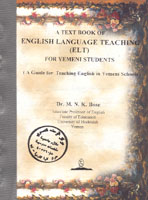
Book ReviewA Text Book of English Language Teaching (ELT) for Yemeni Students(A guide for teaching English in Yemeni schools)By Dr. MNK Bose. Published by Obadi Studies and Publishing Center, Sana’a (P. O. Box 662). 148 pages [Archives:2003/677/Education]
October 16 2003
 |
Dr. MNK Bose’s “A Text Book of English Language Teaching for Yemeni Students” is a pioneering and scholarly study of the problems and prospects relating to the English language teaching enterprise in the secondary schools in the Republic of Yemen. Backed by a wealth of experience as a teacher of English and a teacher educator in premier institutes in India as well as in Yemen Dr. Bose is singularly and uniquely equipped to make a perceptive analysis, with remarkable precision and clarity, of the English as a Foreign Language (EFL) scenario in Yemen which seems to be in cross roads.
This book, the first of its kind in Yemen, exclusively focuses on the Yemeni ELT situation in the broader Arabi context. Most of what the author has stated in this volume is related to Yemeni school classes where English is taught in extremely difficult circumstances. It incorporates Dr. Bose’s interactive experience with his students (teacher trainees) in the Faculty of Education, Hodeidah University and a cross section of teachers teaching in the schools in Hodeidah which he used to visit in connection with teaching practice as well as for classroom observation of pupil teachers.
The basic purpose of the book is to provide some professional help and advice to the teachers of English, and teacher educators in the Faculties of Education in Yemen in the field of ELT, where a little help is available in terms of teaching materials and standard textbooks. In the fitness of things, the book addresses a plethora of pertinent issues including the following:
– How to add variety to and remove boredom from an ELT classroom?
– How effectively and fruitfully can language games be played in an ELT classroom?
– How can language communicative skills be developed in the learner?
– How can we construct a realistic but effective curriculum?
– How can a teacher evaluate the performance of the learner throughout the year?
– How can a teacher construct reliable and valid test materials?
Questions such as these which confront any sensitive ELT professional, especially in Yemeni context, are very insightfully and lucidly discussed through the following fourteen informative units comprising the book:
1. The ELT situation in Yemen
2. The English curriculum for Yemeni schools
3. Approaches, Methods and Techniques in ELT
4. The ELT materials for Yemeni schools
5. The teaching of Oral skills in Yemeni schools
6. The teaching of Reading skills in Yemeni schools
7. The teaching of Writing skills in Yemeni schools
8. The teaching of language elements in Yemeni schools
9. Remedial Teaching
10. Language games for Yemeni learners
11. Lesson planning and Classroom Observation
12. Language testing in Yemeni schools
13. Constructing a language test
14. Applied Linguistics and ELT
Each unit has been ramified into several sub-units to yield a comprehensive perspective to the aspect being highlighted.
Examples, wherever necessary, have been provided from the ‘Crescent English Course for Yemen’ materials which are used in this country.
Several recent works in the field of ELT have been referred to throughout the book, all of which are catalogued in the bibliography. Elaborate quotations from the books referred to have been scrupulously avoided, unless they are necessary, in order to make the reading of the book easy for the readers.
A brief but cryptic summary appended to each unit serves as an effective recap of the main ideas discussed. The author has very thoughtfully added some searching, elicitative questions, not so much to test the reader’s conceptualization of each unit as to provide a roadmap for its better comprehension. The Worksheet that concludes the Unit serves to provide a practical follow-up to the ideas presented.
The book, which has a presentable get-up, has been made as simple and comprehensible as possible, keeping the students’ level in view, at the same time presenting a precious reservoir of practical pedagogic tips for practicing classroom teachers – thus making it an indispensable handbook for both. It has a very rich potential for being adopted as an excellent text book at the Education Faculties, Teacher Training colleges and High Institutes in Yemen.
It is, no doubt, a valuable addition to the ELT materials in Yemen and is expected to adorn the shelves of teachers, teacher trainers, educational administrators, curriculum planners. It is also an invaluable companion to all those who evince some interest in the Teaching of English as a Foreign Language (TEFL) in the Republic of Yemen.
——
[archive-e:677-v:13-y:2003-d:2003-10-16-p:education]


